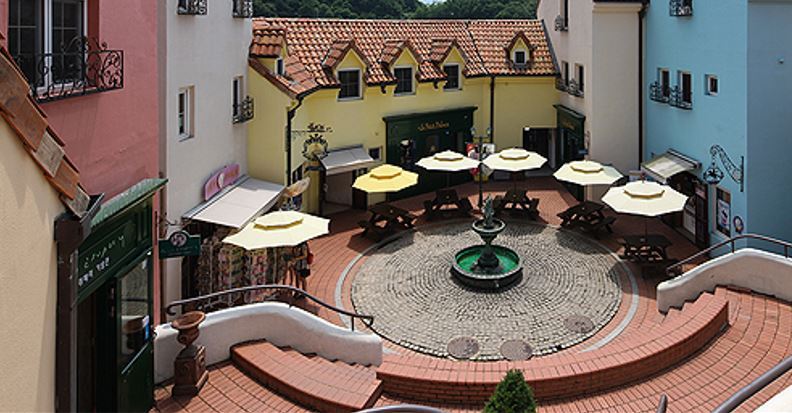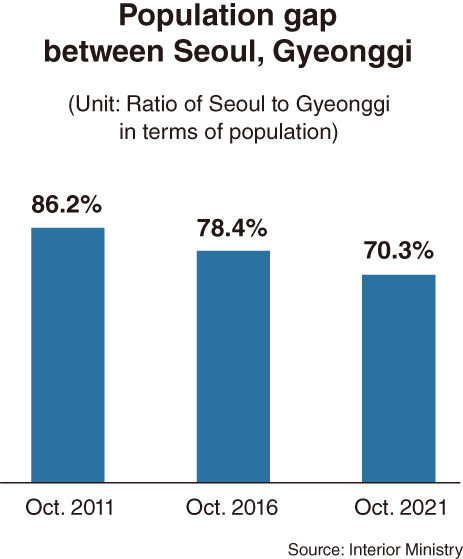
This village, dubbed Petite France, is located in Gapyeong-gun, Gyeonggi Province. As the most populous region in Korea, the province has 28 cities and three “gun.” (Korea Tourism Organization)
SEJONG -- The population gap between Seoul and neighboring Gyeonggi Province has continued to grow in recent months and years, with the province having 4 million more residents than the capital in October, government data showed.
These are the top two populous regions among 17 major cities and provinces in South Korea.
According to the Ministry of Interior and Safety, the population of Seoul posted 9.53 million, which is down 9,828 from a month earlier. The figure for Gyeonggi reached a record-high of 13.54 million, up 7,293 from the previous month.
The widening gap has accelerated over the past decade due to the ongoing increase in the number of residents in Gyeonggi Province since the 1990s, which contrasted with the continuous decline in the population of Seoul since the early 2010s.

(Graphic by Kim Sun-young/The Korea Herlad)
After the province overtook the capital in 2005, the disparity has continued to deepen.
Seoul’s population was 70.2 percent the size of Gyeonggi’s last month, compared to 86.2 percent a decade earlier.
The gap is likely to further widen in the coming months or years, given that Gyeonggi -- alongside Sejong -- is still steady increasing population, despite an overall nationwide decline since December 2019.
While the demographic figure for Gyeonggi had already outstripped that of Seoul plus Busan (the nation’s third-most populous among 17 major cities and provinces with 3.35 million inhabitants), the figure for Seoul is the lowest in about 35 years.
Over the past decade, more households in Seoul and other regions across the country have moved to new residential towns, built in Gyeonggi’s cities such as Goyang, Gimpo, Bucheon, Hwaseong, Suwon, Yongin, Seongnam and Hanam.
As of last month, Suwon had the largest population among 31 cities and "gun" in Gyeonggi with 1.18 million, followed by Goyang (1.08 million), Yongin (1.07 million), Seongnam (931,000), Hwaseong (881,000), Bucheon (808,000), Namyangju (729,000) and Ansan (654,000).
One problem for the province from the growth in population could be a lack of efficacy in carrying out provincial administrative policies.
Some researchers have called for consideration of splitting the province into South Gyeonggi and North Gyeonggi provinces. But no official discussions have happened under the Moon Jae-in government.
Gyeonggi’s population is higher than those of Sweden, Portugal, Greece and Austria, and more than double those of Denmark, Norway, Ireland and New Zealand.
Seoul’s population peaked at 10.32 million in October 2010. And the downhill phase is underway for a decade in the wake of low fertility rates and an exodus from Seoul driven partly by skyrocketing house prices -- particularly under the incumbent administration since 2017.
In addition, relocation of government offices or agencies and some units of Seoul-based conglomerates have affected the sharp decrease in the capital, said a demographic analyst.
For nationwide, the population posted 51.66 million as of October, sliding by 5,398 from a month earlier.
South Korea’s population -- which topped 50 million for the first time in history in September 2010, is estimated to have peaked at 51.85 million in November 2019.
The nation’s demographic tally fell for the 23rd consecutive month, under which the figure for October 2021 is 189,137 lower than the population in November 2019.
Next to Seoul, Busan ranked second in population decline in October, recording minus 2,452 on-month, followed by Daegu with minus 2,066, North Jeolla Province with minus 1,340 and South Gyeongsang Province at minus 1,110.
The figures fell by 1,037 in South Jeolla Province, 830 in Daejeon, 670 in Ulsan, 419 in North Gyeongsang Province and 373 in Gwangju.







